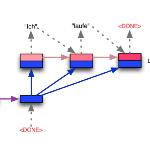Recently, diffusion models have emerged as a new paradigm for generative models. Despite the success in domains using continuous signals such as vision and audio, adapting diffusion models to natural language is under-explored due to the discrete nature of texts, especially for conditional generation. We tackle this challenge by proposing DiffuSeq: a diffusion model designed for sequence-to-sequence (Seq2Seq) text generation tasks. Upon extensive evaluation over a wide range of Seq2Seq tasks, we find DiffuSeq achieving comparable or even better performance than six established baselines, including a state-of-the-art model that is based on pre-trained language models. Apart from quality, an intriguing property of DiffuSeq is its high diversity during generation, which is desired in many Seq2Seq tasks. We further include a theoretical analysis revealing the connection between DiffuSeq and autoregressive/non-autoregressive models. Bringing together theoretical analysis and empirical evidence, we demonstrate the great potential of diffusion models in complex conditional language generation tasks. Code is available at \url{https://github.com/Shark-NLP/DiffuSeq}
翻译:最近,传播模式已成为基因模型的新范例。尽管在使用视觉和音频等连续信号的领域取得了成功,但是由于文本的离散性质,特别是有条件的生成,使传播模式适应自然语言的传播模式没有得到充分探索。我们通过提出DiffuSeq(DiffuSeq):为序列到序列(Seq2Seq)生成文本任务设计的传播模式。在广泛评价一系列Seq2Seq任务之后,我们发现DiffuSeq(DiffuSeq)取得了比六个既定基线的可比较甚至更好的业绩,包括以预先培训的语言模型为基础的最先进的模型。除了质量外,DiffuSeqeq的令人着迷的特性是其生成过程中的高度多样性,许多Seq2Seq任务中也希望如此。我们还包括一项理论分析,揭示DiffuSequ和自制/不偏向性/不向性模型之间的联系。我们把理论分析和经验性证据汇集在一起,我们展示了传播模型在复杂的有条件生成语言任务中的巨大潜力。代码在\urlams/Ngifquus/Squus/Squusb/Sqrf/Sqrfrf/Lws.




